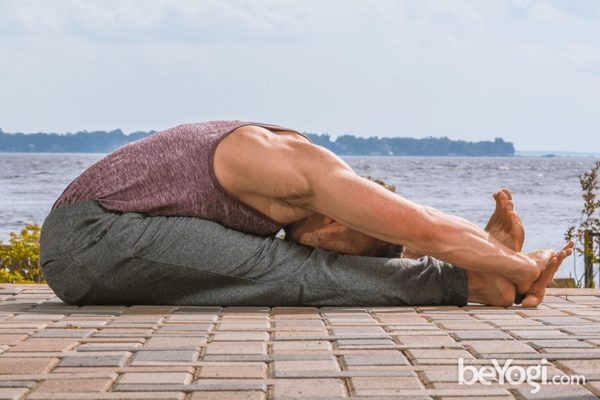
Benefits of Simple Seated Forward Bend Pose Paschimottanasana
Seated forward bend is beginner’s yoga pose with multiple health benefits. Performing this pose gives relief to nervous system, improves digestion. In addition, it tones abdomen and reduces belly fat. This pose stretches the muscle and spine and helps to bend forward. For many this is a calming pose as it reduces anxiety and stress. Women who suffer from menopause symptoms and menstrual pain can get relief by performing this pose – Healthy Life
LEVEL : Beginner
Anatomy: Glutes, Hamstrings, Legs, Lower Back
Pose Type: Forward Bend, Seated
Sanskrit :Paschimottanasana (POSH-ee-moh-tan-AHS-anna) pashima = west uttana = intense stretch, extended
BENEFITS:
- Stretches the hamstrings, shoulders, and lower back
- Lengthens the spine
- Invigorates the nervous system
- Eases the symptoms of menstruation and menopause
- Stimulates the abdominal organs and improves digestion
- Relieves stress, anxiety, and mild depression
CONTRAINDICATIONS
- Tight hamstrings
- Herniated disc(s)
- Enlarged liver or spleen
- Spinal pathologies
- Lower back pain
- Diarrhea
- Asthma
HOW TO
- Come to a seated position and extend your legs in front of you.
- Place your hands on the mat beside your hips. Press down through your hands and flex your feet, coming into Dandasana (Staff pose). Inhale and lift your torso while grounding down through your sitting bones.
- As you exhale, begin to hinge forward at the hips. Maintain a straight spine as you fold forward over your thighs.
- If your fingers reach your toes, clasp the outer edges of your feet with your hands. Otherwise, clasp your ankles or shins. Gaze toward your feet.
- On each inhale, lift and lengthen the torso. On each exhale, release the torso and fold further into the pose. Release your head toward the floor.
- Hold this pose for 8-10 breaths. Then release the hands and come back into Dandasana.
MODIFY OR REPLACE
Alternatives:
Viparita Karani (Legs Up the Wall pose)
Modifications:
Microbend your knee if you feel a stretch behind the joint. You want to feel the stretch in your hamstrings and calves, but not behind the knee.
SEQUENCING TIPS
Before:
- Adho Mukha Svanasana (Downward-Facing Dog)
- Malasana (Garland pose)
After:
- Purvottanasana (Upward Plank)
- Salamba Sarvangasana (Shoulderstand)
TEACHING CUES
- Don’t worry about bending all the way forward in this pose. Focus on alignment. Keep the feet flexed and the spine lengthened.
- With each inhale, find length in the torso. With each exhale, fold a bit deeper into the pose.
- VARIATIONS
- If you are flexible and can reach your feet easily, place a block against the soles of your feet and hold onto the block.
- When you can hold the block with ease, wrap your hands around the bottom of your feet. Grab the left wrist with the right hand; and allow the left hand to come into Gyan mudra.
WATCH OUT FOR
- Folding from the back and not from the hips
- Hunched shoulders
- Hyper-extended knees
- Feet splaying outward or sickling in
This article and image reproduced here with prior permission from BeYogi.com. For more poses visit beyogi.com
Author: Sumana Rao | Posted on: October 6, 2021
« Practice Padahastasana & reduce belly Are you looking for Stress free zone? »






















Write a comment